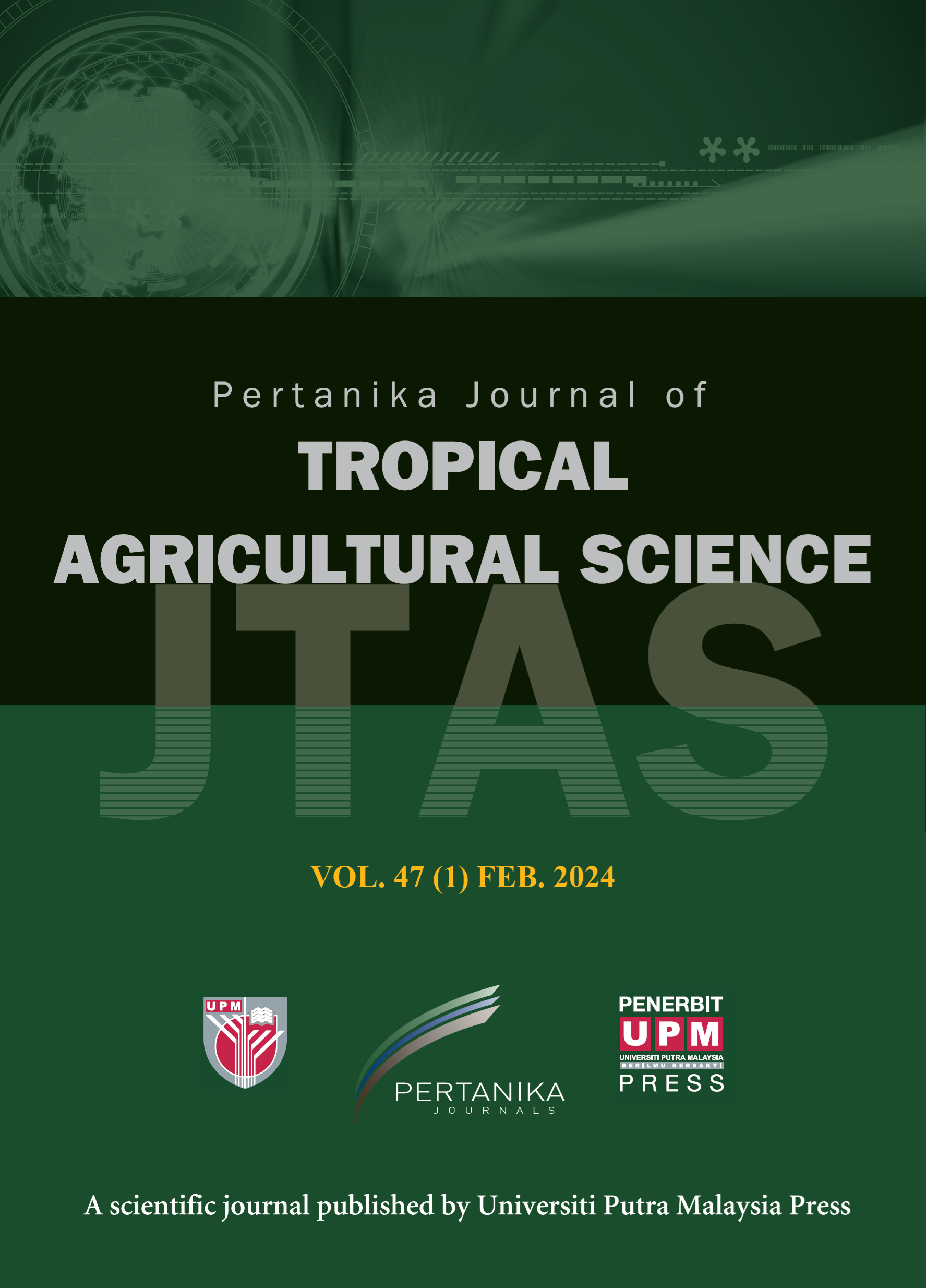PERTANIKA JOURNAL OF TROPICAL AGRICULTURAL SCIENCE
e-ISSN 2231-8542
ISSN 1511-3701
J
J
Pertanika Journal of Tropical Agricultural Science, Volume J, Issue J, January J
Keywords: J
Published on: J
J
-
Ballesteros, L. F., Teixeira, J. A., & Mussatto, S. I. (2014). Chemical, functional, and structural properties of spent coffee grounds and coffee silverskin. Food and Bioprocess Technology, 7, 3493-3503. https://doi.org/10.1007/s11947-014-1349-z
-
Beesigamukama, D., Amoding-Katusabe, A., Tumuhairwe, J. B., Muoma, J., Maingi, J. M., Ombori, O., Nakanwagi, J., & Mukaminega, D. (2018). Agronomic effectiveness of water hyacinth-based composts. African Journal of Agricultural Research, 13(39), 2055-2062. https://doi.org/10.5897/AJAR2018.13440
-
Bray, R. H., & Kurtz, L. T. (1945). Determination of total, organic, and available forms of phosphorus in soils. Soil Science, 59, 39-45.
-
Bremner, J. M., & Mulvaney, C. S. (1982). Nitrogen-Total. In A. L. Page, R. H. Miller & D. R. Keeney (Eds.), Methods of Soil Analysis Part 2 Chemical and Microbiological Properties (pp. 595-942). American Society of Agronomy Inc, Soil Science Society of America Inc.
-
Cervera-Mata, A., Pastoriza, S., Rufián-Henares, J. A., Párraga, J., Martín-García, J. M., & Delgado, G. (2018). Impact of spent coffee grounds as organic amendment on soil fertility and lettuce growth in two Mediterranean agricultural soils. Archives of Agronomy and Soil Science, 64(6), 790-804. https://doi.org/10.1080/03650340.2017. 1387651
-
Cruz, R., Baptista, P., Cunha, S., Pereira, J. A., & Casal, S. (2012). Carotenoids of lettuce (Lactuca sativa L.) grown on soil enriched with spent coffee grounds. Molecules, 17, 1535-1547. https://doi.org/10.3390/molecules17021535
-
Fitrihidajati, H., Rachmadiarti, F., Winarsih, Purnomo, T., & Kuntjoro, S. (2021). Quality of organic fertilizer made from water hyacinth with the addition of corncobs waste and soybean dregs. Journal of Physics: Conference Series, 1899, Article 012024. doi:10.1088/1742-6596/1899/1/012024
-
Gajalakshmi, S., & Abbasi, S. A. (2002). Effect of the application of water hyacinth compost/ vermicompost on the growth and flowering of Crossandra undulaefolia, and on several vegetables. Bioresource Technology, 85(2), 197-199. https://doi.org/10. 1016/ S0960- 8524(02)00096-2
-
Gomes, T., Pereira, J.A., Ramalhosa, E., Casal, S., & Baptista, P. (2013). Effect of fresh and composted spent coffee grounds on lettuce growth, photosynthetic pigments and mineral composition. In VII Congreso Ibérico de Agroingeniería y Ciencias Horticolas (pp. 1-5). SECH e SEAgIng.
-
Haug, R. T. (1993). The Practical Handbook of Compost Engineering. Lewis Publishers.
-
Islam, M. N., Rahman, F., Papri, S. A., Faruk, M. O., Das, A. K., Adhikary, N., Debrot, A. O., & Ahsan, M. N. (2021). Water hyacinth (Eichhornia crassipes (Mart.) Solms.) as an alternative raw material for the production of bio-compost and handmade paper. Journal of Environmental Management, 294, Article 113036. https://doi.org/10.1016/j.jenvman.2021.113036
-
Jafari, N. (2010). Ecological and socio-economic utilization of water hyacinth (Eichhornia crassipes Mart Solms). Journal of Applied Sciences and Environmental Management, 14(2), 43-49.
-
Kasongo, R. K., Verdoodt, A., Kanyankagote, P., Baert, G., & Van Ranst, E. (2011). Coffee waste as an alternative fertilizer with soil improving properties for sandy soils in humid tropical environments. Soil Use and Management, 27, 94-102. https://doi.org/10.1111/j.1475-2743.2010.00315.x
-
Khan, S., & Sarwar, K. S. (2002). Effect of water-hyacinth compost on physical, physico-chemical properties of soil and on rice yield. Journal of Agronomy, 1, 64-65. https://doi.org/10.3923/ja.2002.64.65
-
Malik, A. (2007). Environmental challenge vis a vis opportunity: The case of water hyacinth. Environment International, 33(1), 122-138. https://doi.org/10.1016/j.envint.2006.08. 004
-
Mussatto, S. I., Carneiro, L. M., Silva, J. P. A., Roberto, I.C., & Teixeira, J. A. (2011). A study on chemical constituents and sugars extraction from spent coffee grounds. Carbohydrate Polymers, 83, 368-374. https://doi.org/10.1016/j.carbpol.2010.07.063
-
Mussatto, S. I., Machado, E. M. S., Martins, S., & Teixeira, J. A. (2011). Production, composition, and application of coffee and its industrial residues. Food and Bioprocess Technology, 4, 661-672. https://doi.org/10.1007/s11947-011-0565-z
-
Saengsanga, T. (2018). Isolation and characterization of indigenous plant growth-promoting rhizobacteria and their effects on growth at the early stage of Thai jasmine rice (Oryza sativa L. KDML105). Arabian Journal for Science and Engineering, 43, 3359-3369. https://doi.org/10.1007/s13369-017-2999-8
-
Singh, J., & Kalamdhad, A. S. (2015). Assessment of compost quality in agitated pile composting of water hyacinth collected from different sources. International Journal of Recycling of Organic Waste in Agriculture, 4, 175-183. https://doi.org/10.1007/s40093-015-0097-z
-
Su, W., Sun, Q., Xia, M., Wen, Z., & Yao, Z. (2018). The resource utilization of water hyacinth (Eichhornia crassipes [Mart.] Solms) and its challenges. Resources, 7(3), Article 46. https://doi.org/10.3390/resources7030046
-
Ummah, K., & Rahayu, Y. S. (2019). The effect of gibberellin extracted from Eichhornia crassipes root on the viability and duration of hard seed germination. Journal of Physics: Conference Series, 1417, Article 012037. https://doi.org/10.1088/1742-6596/1417/1/012037
ISSN 1511-3701
e-ISSN 2231-8542




